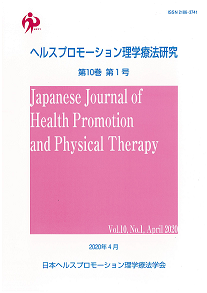Volume 10, Issue 4
Displaying 1-7 of 7 articles from this issue
- |<
- <
- 1
- >
- >|
ORIGINAL ARTICLES
-
Article type: original article
2021Volume 10Issue 4 Pages 163-172
Published: January 28, 2021
Released on J-STAGE: January 29, 2021
Download PDF (701K) -
Article type: orginal article
2021Volume 10Issue 4 Pages 173-181
Published: January 28, 2021
Released on J-STAGE: January 29, 2021
Download PDF (418K) -
Article type: original article
2021Volume 10Issue 4 Pages 183-188
Published: January 28, 2021
Released on J-STAGE: January 29, 2021
Download PDF (358K)
SHORT REPORT
-
Article type: short report
2021Volume 10Issue 4 Pages 189-193
Published: January 28, 2021
Released on J-STAGE: January 29, 2021
Download PDF (324K) -
Article type: short report
2021Volume 10Issue 4 Pages 195-198
Published: January 28, 2021
Released on J-STAGE: January 29, 2021
Download PDF (280K) -
Article type: short report
2021Volume 10Issue 4 Pages 199-202
Published: January 28, 2021
Released on J-STAGE: January 29, 2021
Download PDF (363K)
FIELD REPORT
-
Article type: field report
2021Volume 10Issue 4 Pages 203-207
Published: January 28, 2021
Released on J-STAGE: January 29, 2021
Download PDF (368K)
- |<
- <
- 1
- >
- >|
